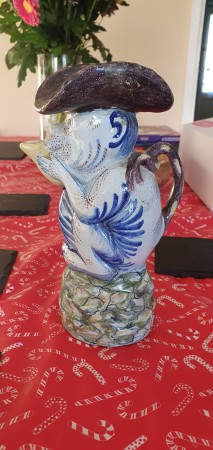i believe an early piece of Delftware in the form of a Monkey eating a banana
Vraag
Does anyone recognize the makers marks and could tell me anymore information about this item than you
Afmetingen
12"x 3"
Collectie
publiekscollectie















Reacties 3
This is a Northern-French copy dating around 1900 with a fake Delft mark.
Kind regards,
Fully agreed with Expert R.L.A. Maes opnion. Regards, Edwin van Drecht.
Verdict:
Analysis:
As the gentlemen above already correctly determined, this is a later French imitation of a Delft as called ‘milk monkey.’ They were indeed jokingly used to poor milk.
Add new comment
Only logged in users can post comments
Log in or register to post comments